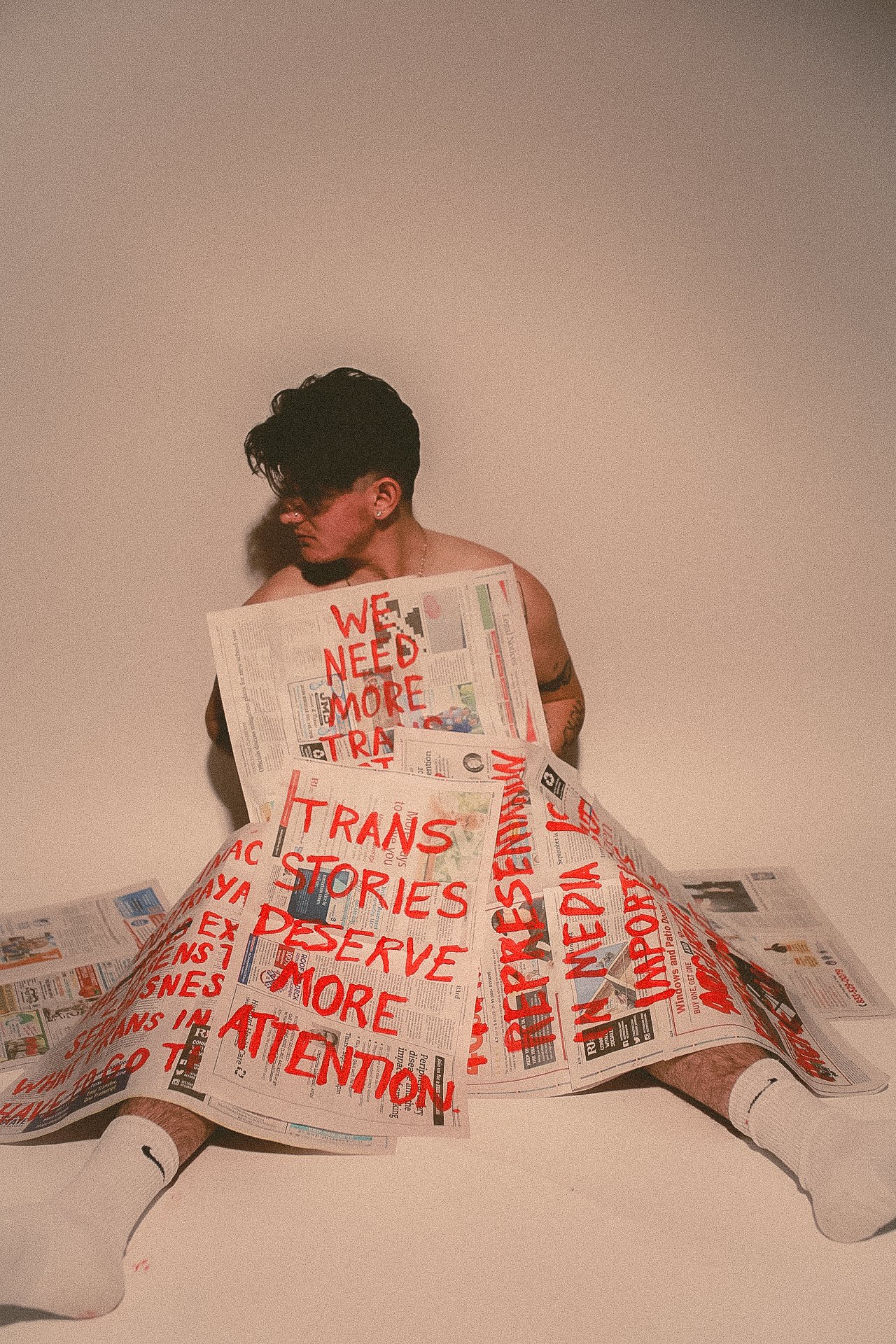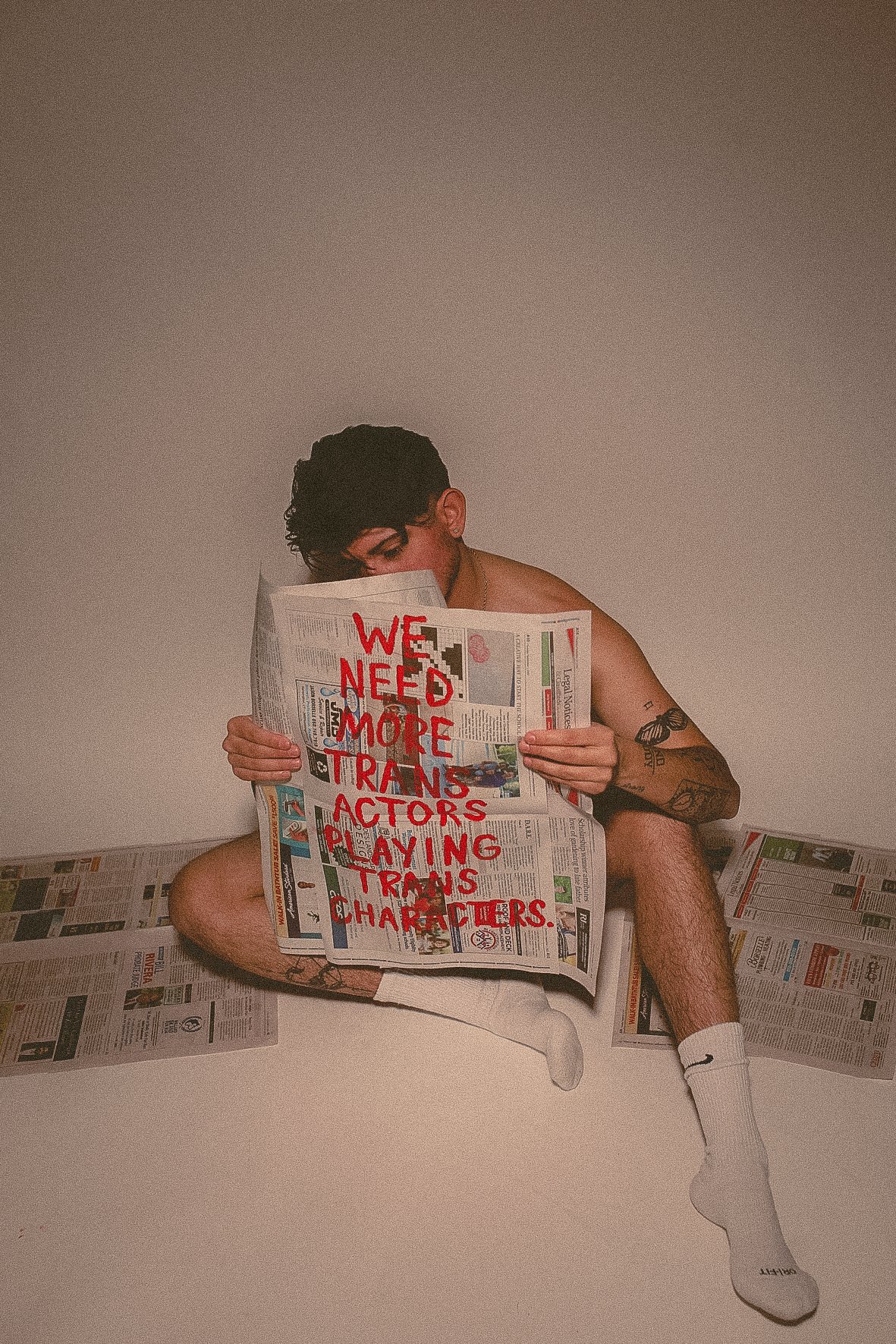Transgender Representation In The Media
As you know, it’s trans awareness week so let’s talk a bit about transgender representation in media…
For those who don’t know, this is how the news, TV, movies, books, etc portray trans stories and characters. I wanted to do a shoot based on this so I thought this was a great opportunity for me to use an actual news outlet and turn it into art. Trans people deserve to be talked about more and represented the correct way in the news. Now transgender representation in media is extremely important but what’s more important is ACCURATE trans representation in media.
Laverne Cox, an American producer and actress, says in the film, Disclosure, that “According to a study by GLAAD, 80% of people don’t actually personally know someone who is transgender.” This means that most of the information people get on the trans community is from media outlets. Unfortunately, the information people are getting from the media is often inaccurate and causes harm on the trans community. The inaccurate portrayal of the trans experience lessens the seriousness of what trans individuals have to go through. This is why we need more trans individuals being outspoken about their experiences in the media raising the correct kind of awareness that needs to be out there for people to learn from.
The trans community faces a lot of discrimination and hate as it is, and the current representation has the power to reinforce those negative stereotypes. Many examples are focused on trans characters in a joking nature, even going as far as to constantly make them the villain, or just constantly reinforcing common misconceptions about the community as a whole. The media is unethical in its portrayal of transgender characters and their experiences. Society needs to hold the media more accountable. You need to stop believing the media and start getting your sources from real trans people. Trans stories deserve more attention. Our voices deserve to be heard because we’re the only ones who can tell an honest and accurate experience of what we go through.
Many cisgender people have never even met a transgender person. These people have absolutely no idea what it means to be trans, especially in today’s society. There is no understanding of experience which causes many people to become prejudice towards the trans community. This spans as far as trans people in movies all the way to transgender medical issues in the scientific news field. This causes harm on a whole new level because of medical treatment for trans individuals. We need the right kind of education of the trans community so that we can be treated fairly and get the proper medical attention that is often overlooked.
In the movies, a common problem is the lack of trans actors playing trans characters. We should not be having straight cisgender actors playing trans characters in the media. This lessens the trans experience and gives an inaccurate depiction of what trans looks like. We need more trans actors playing trans characters.
Cisgender characters are also almost always the hero in the story and there’s rarely an occurrence when there is a transgender hero in any story. They are always depicted as the villain or the outsider that gets made fun of, the list goes on. The first time any film showcased a trans hero was in the 1999 movie, Boys Don’t Cry which tells a story of transgender teen, Brandon Teena, and his experience living and coming out in Nebraska. The movie starred Hilary Swank, a cisgender woman playing a trans male. Tell me something isn’t immediately wrong there? The film is based on a true story about Teena who was raped and murdered in Nebraska so this does bring attention to the violence against the trans community. It made people aware of the trans community as a whole and the violence we face, and finally portrayed a trans character as a hero. But the hero become one for cisgender audiences.For the transgender audience, it was a look onto what could happen if you were to come out.
Even in TV, depictions of trans characters are always played by cis actors and end up getting made fun of. For example, Friends is a popular sitcom from the 1990s. One of the main characters, Chandler is known to have a father who “wears dresses” and “does drag.” The show never addresses Helena as transgender or a cross dresser but the idea of pronouns was always presenting as a joke. Constant “him or her?” jokes were made as well as the character never being seen as an equal in the show. This is just one example of many where the transgender character is treated in a transphobic way. Conversations about trans characters are always directed to talking about their bodies and their private parts and making jokes about “what’s in their pants” or being grossed out by it. There’s a scene in Family Guy where Brian has a one night stand with a trans character, Ida, and after finding out of her trans identity, vomits on screen for 30 seconds. This demonstrates one of the many stigmas that the trans community faces. It always displays an inaccurate knowledge of sex and gender and gives the audience the wrong idea of the trans community. It shows us as people to be made fun of or people to be scared of, which we are not.
Trans representation in media is vital in order to give proper visibility to the transgender community. This misconception does nothing to educate people watching, reading, or listening at home. Fighting this topic of inaccurate trans representation in the media with my art is the one way I hope to educate.






